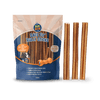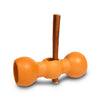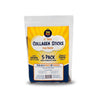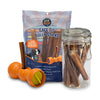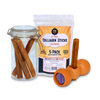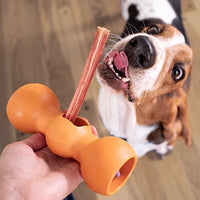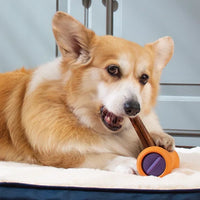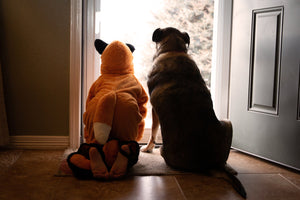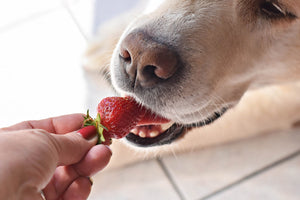Your adorable new bundle of fur is bringing joy to your home, providing loving snuggles and building a bond that will last their lifetime. Let’s be honest, puppies are so much fun, and nothing quite compares to them. But what comes with the joy of being a puppy parent is the occasional chewed shoe, destroyed pillow or torn sock.
This isn’t because you have a “bad” puppy, but rather because they are going through a lot of transitions in their early months. This includes learning (puppies explore with their mouths), teething and managing boundless energy that can easily lead to boredom and mischief.
Today we’re addressing the many reasons puppies chew so you can better understand this behavior. It’s completely normal, and when guided properly, it plays an important role in your puppy’s development. Once you understand why your puppy is chewing, you’ll be better prepared to help guide them toward safe, appropriate options instead of your shoes, furniture or the corner of the rug.

Why Puppies Chew
Chewing isn’t just about teething, though that’s a big part of it. Puppies are born with 28 deciduous, or “baby,” teeth. These start to come in around 3 weeks of age and act as placeholders for the 42 adult teeth that will eventually replace them. Adult teeth begin erupting around 12–16 weeks, and by 6–7 months of age, your puppy should have their full set in place.
Just like children, puppies experience gum soreness and discomfort as teeth loosen and fall out. Chewing helps relieve that pressure. But puppies also chew for other reasons:
- Exploration: Dogs learn about the world with their mouths. “Tasting” is another way they gather information.
- Mental stimulation: Chewing keeps their minds busy and can actually help support a calmer, less anxious puppy.
- Stress relief and boredom-busting: Puppies use chewing as a natural outlet for energy and emotions.
- Oral health: Gentle daily chewing helps keep plaque and tartar from building up, strengthens gums and sets the stage for better dental health throughout your dog’s life.
What to Expect During Teething
During the teething process, you may notice signs like drooling, red or swollen gums, increased chewing or even tiny spots of blood on toys. This stage is temporary, but it can feel intense for both puppy and pet parent.
Teething tends to follow a loose timeline:
- 3–4 months: Front incisors and canines begin to fall out.
- 4–5 months: Premolars erupt, chewing often increases dramatically.
- 5–6 months: Molars arrive, usually the most uncomfortable stage.
- 6–7 months: All 42 adult teeth are in place and teething ends.
Knowing the timeline can help you anticipate when chewing will peak and reassure you that the most challenging phase won’t last forever.
Safe vs. Unsafe Chews for Puppies
Because puppy teeth have thinner enamel and are more fragile than adult teeth, hard chews can easily cause fractures. And a fractured baby tooth doesn’t just hurt, it can create infection or interfere with how the adult tooth develops.
Supervised safe chew options for teething puppies include:
- Soft rubber toys (like Kongs or puppy-specific ones)
- Frozen washcloths (dampen, twist and freeze for soothing relief)
- Frozen apple slices (offer a gentle crunch while the cold soothes gums)
- Puppy-specific chews (like collagen sticks or thin bully sticks secured in a Bow Wow Buddy®)
Chews to avoid for young puppies:
- Antlers, hooves and real bones (too hard, risk of fractures and splintering possible)
- Very hard nylon toys
- Rocks, sticks or anything found outside (risk of splinters, choking or toxins)
- Long-term unsupervised access to thick bully sticks or yak chews (too hard during the teething period)
Once your puppy has all their adult teeth, you can gradually introduce firmer chews. A good rule of thumb: if you can’t press your fingernail into it and make a dent, it’s too hard for your puppy’s teeth.

Preventing Destructive Chewing
This life stage is a phenomenal opportunity to teach your puppy wanted behaviors. Puppies are incredibly smart and impressionable during this time. When you offer the right chew items and redirect them from chewing on unwanted objects, you’re teaching them what’s appropriate and what’s off-limits. These lessons will stick with them for life.
The key is not to yell or reprimand, as this can frighten your puppy and even damage the trust you’re building. Instead, use gentle redirection and praise to guide them toward success. After all, we all learn better when we’re shown what to do, rather than just told what not to do.
Here are a few helpful strategies to set your puppy up for success:
- Supervise and redirect: If your puppy grabs a shoe, calmly take it away and offer an approved chew instead. Praise when they make the right choice by saying “good boy/girl” as soon as they start chewing the proper item.
- Puppy-proof your space: The easiest way to protect your puppy and your belongings is prevention. Keep small or dangerous items out of reach, such as remotes, shoes, socks, cords and children’s toys. Remember, puppies shouldn’t have free range of the home unsupervised until they are older and understand the boundaries you’ve set.
- Rotate chew toys: Puppies, like young children, get bored quickly. Keep them engaged by rotating chew options every few days. Reserve one or two special chews for extra excitement.
- Offer enrichment alternatives: Sometimes chewing happens simply because your puppy is understimulated. Snuffle mats, puzzle feeders, short training sessions or play breaks can redirect energy and reduce destructive chewing.
Setting Your Puppy Up for Success
Chewing is a natural and necessary behavior for your growing puppy. When it’s guided the right way early on, it helps build healthy routines that carry into adulthood. Even after the teething stage passes, the urge to chew doesn’t just disappear, and that’s a good thing. Ongoing chewing helps prevent boredom, supports mental well-being and promotes oral health, especially when your dog gets safe chewing opportunities every day.
With a little knowledge, some patience and the right tools, you can protect your home while helping your puppy develop habits that will keep them happier and healthier for a lifetime.
Johnna Devereaux is a Clinical Pet Nutritionist, canine wellness expert and Chief Nutrition Officer for Bow Wow Labs.
* This article is for informational purposes only. It is not, nor is it intended to be, a substitute for professional medical or veterinary advice, diagnosis, or treatment and should never be relied upon or perceived as specific medical or veterinary advice.
**The points of view expressed above are those of our clinical nutritionist and are supported by science, her education and experience. We are committed to providing the best, most straightforward, and most helpful information possible to help keep your dog happy, healthy and safe.


